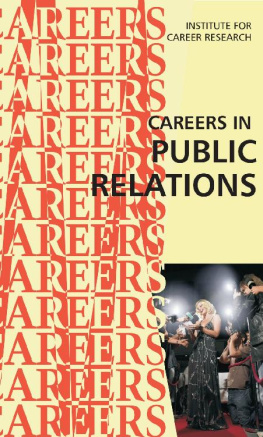
THE FIVE PATTERNS OF EXTRAORDINARY CAREERS
THE GUIDE FOR ACHIEVING SUCCESS AND SATISFACTION
James M. Citrin & Richard A. Smith

CONTENTS
Why those who rise to the top and prosper follow five simple patterns that can be harnessed and used by everyone.
People with extraordinary careers understand how value is created in the workplace, and translate that knowledge into action, building personal value over each phase of a career.
People with extraordinary careers dont claw their way to the top, they are carried there.
People with extraordinary careers overcome one of the great Catch-22s of business: You cant get the job without experience, and you cant get experience without the job.
People with extraordinary careers storm past their defined jobs to create breakthrough ideas and deliver unexpected impact.
People with extraordinary careers make decisions with the long term in mind, and they move toward positions that fit their natural strengths and passions and work with people they like and respect.
Companies with extraordinary performance records do not merely recruit successful people, they create them.
Notes
Introduction
1. David A. Lord, CEO, Executive Search Information Services.
2. The Organization Man, William H. Whyte, Joseph Nocera, Jenny Bell Whyte, University of Pennsylvania Press, 2002; The Man in the Gray Flannel Suit, Sloan Wilson, Bentley Publishers, 1980.
3. Why CEOs Are Prone to Leave Their Posts, Samantha Marshall, Wall Street Journal (accessed at www.careerjournal.com), and Turnover at the Top, Drake Beam Morin, June 12, 2002.
4. Strategic Rewards: Managing Through Uncertain Times, Watson Wyatt Worldwide research report, 2002 (www.watsonwyatt.com).
5. Tech Advances Raise Job Insecurity, Beth Belton, USA Today, February 17, 1999.
Pattern I: Understand the Value of You
1. Its Not About the Bike: My Journey Back to Life, Lance Armstrong, Sally Jenkins, Berkley Publishing Group, 2001.
2. Zoom: How 12 Exceptional Companies Are Navigating the Road to the Next Economy, James M. Citrin, Currency Doubleday, 2002.
3. Who Says Elephants Cant Dance? Inside IBMs Historic Turnaround, Louis V. Gerstner Jr., HarperBusiness, 2002.
4. The War for Talent, Ed Michaels, Helen Handfield-Jones, Beth Axelrod, Harvard Business School Press, 2001.
5. Spencer Stuart CEO survey, June 2002.
6. Ibid.
7. Take on the Street: What Wall Street and Corporate America Dont Want You to Know, Arthur Levitt, Paula Dwyer, Pantheon Books, 2002.
Pattern 2: Practice Benevolent Leadership
1. Swim with the Sharks Without Being Eaten Alive: Outsell, Outmanage, Outmotivate, and Outnegotiate Your Competition, Harvey Mackay, Kenneth H. Blanchard, Fawcett Books, 1989.
2. Michael Ovitz: Hollywoods Comeback Kid, BusinessWeek Online, April 2000 (http://www.businessweek.com/bwdaily/dnflash/ apr2000 /nf00414e.htm); Michael Eisner: Mouse in a Gilded Mansion, Forbes.com, April 26, 2001 (http://www.forbes.com/2001/04/26/ eisner.htm).
3. The Dark Side of Charisma, Robert Hogan, Robert Raskin, Dan Fazzini, Leadership Library of America, 1990.
4. Good to Great: Why Some Companies Make the Leap... and Others Dont, Jim Collins, HarperCollins, 2001.
5. Spencer Stuart CEO survey, June 2001.
Pattern 3: Overcome the Permission Paradox
1. At http://volcanoes.usgs.gov/Hazards/What/Lahars/lahars.htm.
2. Leadership Without Easy Answers, Ronald A. Heifetz, Belknap Press, 1994.
3. Lessons from the Top: The 50 Most Successful Business Leaders in Americaand What You Can Learn from Them, Thomas J. Neff, James M. Citrin, Paul B. Brown, Currency/Doubleday, 2001.
4. GE Mentoring Program Turns Underlings into Teachers of the Web, Matt Murray, Wall Street Journal, February 15, 2000.
5. Leading Up: How to Lead Your Boss So You Both Win, Michael Useem, Crown Business, 2001, p. 292.
6. CNBC Market Dispatches, December 26, 2002 (transcript available at http://moneycentral.msn.com/content/CNBCTV/Articles/ Dispatches /P36658.asp).
7. Forbes, October 19, 1987, cover story, p. 122.
Pattern 4: Differentiate Using the 20/80 Principle of Performance
1. NHTSA Report no. DOT HS 806 572, Final Regulatory Impact Analysis; Amendment to Federal Motor Vehicle Safety Standard 208; Passenger Car Front Seat Occupant Protection, pp. IV-3IV-16 (http://www.nhtsa.dot.gov/cars/rules/regrev/evaluate/806572.htm).
2. The March of Progress, Jerry Useem, Business 2.0. August 2001 (http://www.business2.com/articles/mag/print/0,1643,16689,00.htm).
3. Paul Reveres Ride, David Hackett Fischer, Oxford University Press, 1995.
4. Ibid., pp. 5659.
5. Michael Reene, vice president/general manager, ChoicePoint, Inc.
6. How to Win Friends and Influence People, Dale Carnegie, Dorothy Carnegie, Arthur R. Pell, Pocket Books, 1998.
7. http://www.fortune.com/fortune/bestcompanies.
8. Right Away and All at Once: How We Saved Continental, Greg Brenneman, Harvard Business Review, SeptemberOctober 1998; From Worst to First: Behind the Scenes of Continentals Remarkable Comeback, Gordon Bethune, John Wiley and Sons, 1998.
Pattern 5: Find the Right Fit (Strengths, Passions, and People)
1. How to Stay Stuck in the Wrong Career, Herminia Ibarra, Harvard Business Review, December 1, 2002.
2. Investment Under Uncertainty, Avinash K. Dixit, Robert S. Pindyck, Princeton University Press, 1994.
3. First, Break All the Rules: What the Worlds Greatest Managers Do Differently, Marcus Buckingham, Curt Coffman, Simon & Schuster, 1999.
The Patterns of Extraordinary Organizations
1. The War for Talent, Ed Michaels, Helen Handfield-Jones, Beth Axelrod, Harvard Business School Press, 2001.
2. The Tipping Point, Malcolm Gladwell, Little, Brown and Company, 2000.
3. Spencer Stuart Venture Capital Study survey, November 2001.
4. The Talent Myth: Are Smart People Overrated? The New Yorker, July 22, 2002 (http://www.gladwell.com/2002/2002_07_22_a_talent. htm).
5. Creative Destruction: Why Companies That Are Built to Last Underperform the Marketand How to Succesfully Transform Them, Richard Foster, Sarah Kaplan, Doubleday, 2001.
6. Leading the Revolution, Gary Hamel, Harvard Business School Press, 2000.
7. The War for Talent.
8. The Tipping Point.
Conclusion: Putting the Patterns into Practice
1. Emotional Intelligence, Daniel Goleman, Bantam Books, 1997, pp. 8183.
INTRODUCTION:
The Five Patterns of Extraordinary Careers
You dont just luck into things as much as youd like to think you do. You build step by step, whether its friendships or opportunities.
Barbara Bush
We must believe in luck. For how else can we explain the success of those we dont like?
Jean Cocteau
T he Five Patterns of Extraordinary Careers reveals the subtle yet powerful factors that determine career success: why some people ascend to the top and prosper, while others who are equally talented never reach their expectations. The latter was a fate Timothy Reynolds suddenly feared might have fallen upon him.
Next page






